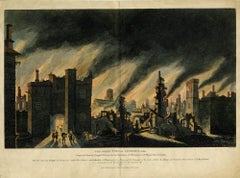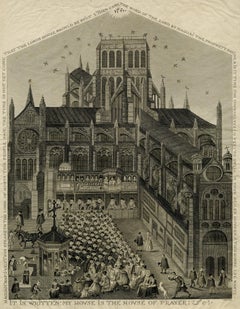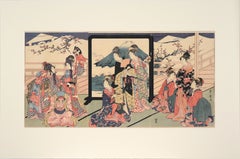James Stow Art
to
2
1
1
2
Overall Height
to
Overall Width
to
2
1
1
1
1
1
2
6,997
3,373
2,513
1,212
2
2
2
1
1
Artist: James Stow
The Great Fire of London, 1666
By James Stow
Located in Middletown, NY
A rare early 19th century view of the Great Fire of London over Ludgate, enhanced with hand coloring.
London: Robert Wilkinson, 1811.
Copperplate engraving with hand coloring in wa...
Category
Early 19th Century English School James Stow Art
Materials
Engraving, Watercolor, Handmade Paper
St. Paul's Cross
By James Stow
Located in Middletown, NY
London: Robert Wilkinson, c1620
Engraving on thin Japon paper,16 1/8 x 11 3/4 iches (408 x 297 mm), narrow margins. In good condition with some age-related toning and edge wear, including two small horizontal tears which appear at the right and left center sheet edges. There is a vertical edge tear on the the lower sheet edge which is expertly repaired with a tab of paper tape mounted to the verso, and a soft horizontal fold, as issued. Plate created circa 1620, however printed later, likely early 19th century.
Dr. John King preaching at St. Paul's Cross for James I, his Queen, Charles Prince of Wales...
Category
17th Century English School James Stow Art
Materials
Engraving, Handmade Paper
Related Items
"Toy Horse Dance" Japanese Woodblock Triptych with Beauties and Mt Fuji
Located in Soquel, CA
"Toy Horse Dance" Japanese Woodblock Triptych with Beauties and Mt Fuji
Vibrant three-panel woodblock print by Utagawa Toyohiro (Japanese,...
Category
Early 20th Century Edo James Stow Art
Materials
Woodcut, Rice Paper, Ink
Utagawa Toyohiro"Toy Horse Dance" Japanese Woodblock Triptych with Beauties and Mt Fuji, early 1900s
H 24 in W 36 in D 0.25 in
"King of the Friendly Islands" (Tonga); Engraving from Captain Cook's 3rd Voyage
By John Webber
Located in Alamo, CA
"Poulaho, King of the Friendly Islands, Drinking Kava" is an engraving created by William Sharp (1749-1824), from a drawing by John Webber (1752-1793), who was the artist on Captain James Cook's 3rd and final voyage of discovery. It was published in the atlas of "A Voyage to the Pacific Ocean Undertaken by the Command of His Majesty, for Making Discoveries in the Northern Hemisphere", the official British Admirality sanctioned journal published upon completion of the voyage in London in 1784 by Strahan & Cadell.
Captain Cook visited Tonga on his 3rd voyage, which he named The Friendly Islands because of the warm welcome he and his crew received, unlike some of the other more hostile Pacific islands. The engraving depicts Cook and his men observed a kava ceremony at the village of Mu’a on Tongatapu. King Paulaho sits in the centre foreground, his back to the spectator with a man kneeling before him. The ceremonial mat depicted behind Paulaho indicates that nobody was allowed to sit behind him. The figure in the centre holds a single cup, referring to the Tongan custom of offering the cup to the king first. Kava is native to the islands of the South Pacific and was first described for English readers in 1768 by Captain James Cook. The kava root has been used for centuries as a central feature of ceremonies and celebrations because it was able to bring about a calming and pleasant social atmosphere. The root was crushed and processed into coconut milk to become the focal ceremonial beverage, simply referred to as kava.
This engraving is presented in a Koa wood frame and a white mat. Koa wood is legendary in Hawaii. There are occasional faint spots, but the print is otherwise in very good condition. This amazing Koa wood is native to Hawaii and it is known for the deep rich colors and varied grain pattern. Koa has an honored heritage in Hawaii and is highly revered and sacred. The word “koa” means “warrior” in Hawaiian. The warriors of King Kamehameha the Great, created canoes and weapons from a wood plentiful on the Big Island of Hawaii. This wood became synonymous with the warriors themselves, and it became known as koa.
There are three other engravings listed from the official journal of Captain Cook's 3rd voyage available that are presented in identical Koa wood frames and mats (LU117324682422, LU117324684052, LU117324684032). They would make a wonderful grouping for a display of 2, 3 or 4 prints. A discount is available for a grouping depending on the number of items included.
Captain Cook is remembered as one of the greatest explorers and navigators in history. His explorations included Australia, New Zealand and islands of the South Pacific and the northwest coast of North America. Hawaii was discovered by Captain Cook during this voyage. Hawaii was originally called The Sandwich Islands in honor of The Earl of Sandwich...
Category
1780s Realist James Stow Art
Materials
Engraving
H 18.25 in W 23.5 in D 0.88 in
ICE CREAM DESSERTS
By Claes Oldenburg
Located in Aventura, FL
Hand initialed and numbered by the artist. Etching and aquatint in colors, on handmade paper. Image size: 13.5 X 21.25 in. Sheet size: 22.5 x 31.25 in. Framed. Edition of 50. Artwor...
Category
1970s Pop Art James Stow Art
Materials
Handmade Paper, Aquatint, Etching
Kiyomizu Temple, Scenes of Famous Places along Tôkaidô Road - Woodblock on Paper
By Utagawa Hiroshige II
Located in Soquel, CA
Kiyomizu Temple, Scenes of Famous Places along Tôkaidô Road - Woodblock on Paper
Full Title:
Kyoto: Kiyomizu Temple (Kyô Kiyomizudera), from the series Scenes of Famous Places along...
Category
1860s Edo James Stow Art
Materials
Ink, Rice Paper, Woodcut
"First Horse Day, 1896" - Chiyoda Palace - Japanese Woodblock by Chikanobu Yoshu
By Toyohara Chikanobu
Located in Soquel, CA
"First Horse Day, 1896" - Chiyoda Palace - Japanese Woodblock by Chikanobu Yoshu
Colorful and expressive court scne by Toyohara Chikanobu,"Yoshu" (Japanese, 1838-1912).
This is the r...
Category
1890s Edo James Stow Art
Materials
Rice Paper, Ink, Woodcut
H 15 in W 10.5 in D 0.5 in
Festival Procession Of A Daimyo - Original Woodblock Print
Located in Soquel, CA
Procession Of A Daimyo - Original Woodblock Print
Original woodblock print depicting the procession of a Daimyo. Ten Japanese soldiers are seen as they aid in transporting the Daimy...
Category
Late 18th Century Edo James Stow Art
Materials
Ink, Wood Panel, Rice Paper
Deutzia Flowers: The Wife of Kasamori - Original Woodblock Print
Located in Soquel, CA
Deutzia Flowers: The Wife of Kasamori - Original Woodblock Print
Deutzia Flowers: The Wife of Kasamori, from the Series "Beauties of the Floating World Associated with Flowers" by S...
Category
1760s Edo James Stow Art
Materials
Woodcut, Ink, Rice Paper
H 18 in W 14 in D 0.5 in
Yellow Sky, Limited edition print, Landscape, Animal, Cowboy, Horses, Western
Located in Deddington, GB
Yellow Sky is a limited edition drypoint print by artist Kate Boxer, featuring two cowboys riding through a dessert scene. Kate Boxer, artist and printmaker, is available online and ...
Category
2010s Contemporary James Stow Art
Materials
Drypoint, Paper
H 27.17 in W 27.17 in D 0.2 in
I Won't Eat You, Limited edition print, Animal print, Lion, Yellow, Illustrative
Located in Deddington, GB
I Won't Eat You by Kate Boxer is a limited edition drypoint etching. This contemporary art print with gouache depicts a lion and is a humorous work of art by Kate Boxer. Kate Boxer m...
Category
2010s Contemporary James Stow Art
Materials
Paper, Oil Pastel, Mixed Media, Drypoint, Etching
H 36.23 in W 48.04 in D 0.04 in
Japanese Beauty Admiring Kirifuri Waterfall
By Yoshu Chikanobu
Located in Burbank, CA
A beauty turns to admire the Kirifuri Waterfall in Nikko Province. She holds the handle of an umbrella and wears fashionable clothing that is beautifully printed. This series pairs f...
Category
1890s Edo James Stow Art
Materials
Mulberry Paper, Handmade Paper, Woodcut
Mitate of a Daimyo's Procession Crossing Ryogoku Bridge - Woodblock Print
By Keisai Eisen
Located in Soquel, CA
Mitate of a Daimyo's Procession Crossing Ryogoku Bridge - Woodblock Print
Woodblock print of a procession by Keisai Eisen (Japanese, 1790–1848). Terrific triptych of a procession of...
Category
Early 19th Century Edo James Stow Art
Materials
Woodcut, Rice Paper, Ink
H 24 in W 36 in D 0.25 in
"Various Himochi" Wagashi Festival Japanese Woodblock Print by Utagawa Toyokuni
Located in Soquel, CA
"Various Himochi" Wagashi Festival Japanese Woodblock Print by Utagawa Toyokuni
Rare oversized early 19th century 5-tiered woodblock by Utagawa Ichiyosai Toyokuni, (Japan, 1769-1825), a Japanese lord and wife oversee a sekku festival of food, music, and dolls or toys. '"oshi" is the first day of “Mi (Snake)” in the third month of the lunar calendar. This day, known in modern Japan as the Girls' Festival, originated in China as a form of purification ceremony in which water and drinking peach blossom wine were used to drive away evil. Many kinds of hishi-mochi appear in this picture of hina ningyo (dolls associated with Hinamatsuri, or the Girl’s Day) from Omochae.
The custom of eating special dishes at events throughout the year and at milestones in people's lives has existed since ancient times. This paragraph specifically focuses on the annual event called sekku, and life events that involve eating sweets. Joshi is the first day of “Mi (Snake)” in the third month of the lunar calendar. This day, known in modern Japan as the Girls' Festival, originated in China as a form of purification ceremony in which water and drinking peach blossom wine were used to drive away evil. According to the Keiso saijiki, in ancient China, on the third day of the third lunar month, people ate “ryuzetsuhan,” which is the juice of gogyo (Jersey cudweed) mixed with rice flour and nectar. In Japan, there is a record in the Heian period history book Nihon Montoku tenno jitsuroku [839-5] that it was an annual event to make kusamochi using gogyo on the third day of the third month of the lunar calendar, which may have been influenced by Chinese customs.
The tradition of eating kusamochi on the third day of the third month of the lunar calendar continued after that. By the Edo period, however, hishimochi had come to be used as a sweet to serve on the third day of the third month. A picture of a hishimochi is included in the Morisada manko , which we mentioned in Part 1. According to it, hishimochi in the Edo period were often three layers of green-white-green instead of the now common red-white-green. However, it is possible to see from our collection that not all hishimochi were made in this way. Omochae published in 1857, is a good example. Omochae is a type of ukiyoe print...
Category
1820s Edo James Stow Art
Materials
Ink, Rice Paper, Woodcut
H 26.75 in W 21.75 in D 0.25 in
James Stow art for sale on 1stDibs.
Find a wide variety of authentic James Stow art available for sale on 1stDibs. You can also browse by medium to find art by James Stow in engraving, handmade paper, paint and more. Not every interior allows for large James Stow art, so small editions measuring 17 inches across are available. James Stow art prices can differ depending upon medium, time period and other attributes. On 1stDibs, the price for these items starts at $300 and tops out at $300, while the average work can sell for $300.



